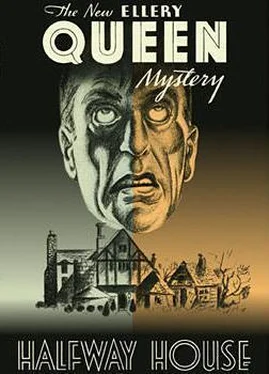“Pshaw! If the murderer killed Gimball-Wilson, the man of two lives, knowing that he was killing Gimball-Wilson, the inevitable question was: How had the murderer learned of those two lives? How did he know that Gimball of New York, the society man, was also Wilson of Philadelphia, the itinerant peddler? For years Gimball had taken every precaution to keep his double life a dead secret; for years no one suspected; for years apparently Gimball made no mistake and went unsuspected; and Wilson kept his Gimball identity equally secret for the same length of time. He had told Bill here in so many words, according to the story Bill told De Jong and me on the night of the crime, that no one he knew was aware of the existence of the shack. Yet the murderer chose Halfway House for the scene of the crime. True, Gimball meant to reveal his secret to Bill and Andrea that night, but he was murdered before he could carry out his intention. Had he meant to tell a third person, he would have certainly told that third person no earlier than the night of the murder. Yet the murderer knew the whole story. How, then, had the murderer learned it?”
“That was the logical question, of course,” nodded the Judge.
“And there was a logical answer to it,” drawled Ellery.
“But couldn’t he have learned the story,” demanded Bill from the sofa, “by sheer accident?”
“Possibly, of course, but very unlikely. Gimball, we know on good authority, never relaxed his vigilance. The two telegrams, had they fallen into the hands of the murderer, would have revealed nothing but the location of Halfway House — I love that phrase! But if the location of the place had been the only thing the murderer learned, it would not have been enough. The murderer must have known well in advance of the day Gimball sent the telegrams — the day he died — all about the Gimball personalities. He had to know not only the location of Halfway House but the identity of Gimball’s real wife, where she lived, something of her character and background. He had to have time to plan the crime, to find out about Lucy’s car, to learn her Saturday-night movie habit so that he could depend on her probable lack of an alibi, and so on. All this would have taken time. Not a day — perhaps more than a week, if the man were investigating surreptitiously as he must have. No, Bill, hardly an accidental discovery.”
“Then how?” cried Pollinger.
“How? There was one means by which the murderer could have learned which was so plain I couldn’t ignore it. While it’s impossible by pure logic to eliminate beyond doubt the murderer’s accidental discovery of Gimball’s dual-life background, we can discard the unlikely accident-theory for a positive indication, which clearly exists. Gimball was slain very shortly after he decided to make a clean breast of his predicament and tell the story of his double life to representatives of both his families. When you consider that his first step along the road to confession was to change his insurance-policy beneficiary from his false wife Jessica to his true wife Lucy, the fact becomes too overwhelming to be coincidence. Don’t you see? At last there was a record of his double life — nine records, so to speak: the name and address of the new beneficiary on the original application and on the eight revised policies! And then, on the heels of these records, he was murdered. How could I doubt that it was by this means that the murderer had learned that Gimball was Wilson and Wilson Gimball? Anyone who learned of this change, or had access to the policies, could have investigated; learned the secret from the name and address; followed Gimball on one of his stopovers at Halfway House; and in two weeks discovered all that was necessary to plan the murder and implicate Lucy as the murderess.”
Lucy was crying softly; Andrea sat up and put her arm around the weeping woman. At the spectacle Bill began to smile rather fatuously, like a proud parent watching the antics of his two children.
“And so,” said Ellery, “I now had a complete portrait of the criminal. I’ll give the characteristics numerically.
“1. The criminal was a man.
“2. The criminal was a smoker, probably a pipe-smoker, certainly heavily addicted to the weed, for only one chronically in the grip of tobacco would have resorted to it on the scene of an intended crime while waiting for his victim.
“3. At the time of the murder the criminal carried a monogrammed or similarly identifiable match-packet.
“4. The criminal had motive against both Gimball and Mrs. Wilson.
“5. The criminal had no writing implement on his person, or the one he did have he preferred not to use because its use might in some way be traceable to him.
“6. The criminal came most probably from the Gimball side of the fence — his deliberate framing of Lucy implied that.
“7. The criminal had a tender feeling for Andrea, indicated by the mildness of his attacks despite great provocation. The criminal had an even tenderer feeling for Andrea’s mother, for he didn’t once attempt to carry out his threat to harm her — an attempt which, had it been made even as a feint, would have very effectually sealed Andrea’s mouth forever.
“8. The blow which killed Gimball, said the coroner, was delivered with a right hand. So the criminal used his right hand.
“9. The criminal knew that Gimball had changed the beneficiary of his policy.”
Ellery smiled. “In mathematics, you know, you can do a lot of tricks with the number nine. Now let me show you a little trick I was able to do in a murder-case with the same number. With nine definite characteristics of the murderer, the analysis became child’s-play. All I had to do was to go through my list of suspects and test each one against the nine characteristics.”
“Fascinating,” beamed Judge Menander. “Do you mean to say that by this method you can reach a definite conclusion?”
“By this method,” retorted Ellery, “I can eliminate every suspect but one. I’ll discuss them one by one.
“In the first place, of course, point number one eliminates in a single swoop all women. The criminal had to be a man. Who are the men? Well, old Jasper Borden first...”
“Oh!” gasped Andrea. “You horrid thing! Do you mean to say that you suspected Grandfather for a single instant?”
Ellery grinned. “My dear child, everyone is suspect in an objective analysis; we can’t afford to be sentimental because one person is old and decrepit and another young and beautiful. As I say, Jasper Borden. Well, you say, he’s an invalid; he never leaves his house; this was the crime of an active man; and all that is quite true. But let’s pretend that this is a detective story where Mr. Borden would probably have been shamming and slipping out of his Park Avenue apartment quite spryly at ungodly hours and doing all sorts of dreadful things under cover of the night. How do we stand, logically speaking, on Jasper Borden? Well, he is eliminated on point two completely: he does not smoke any more, as he told me before a witness — his grim nurse, who certainly was in a position to deny this if it hadn’t been true. Besides, since this isn’t a detective story, we know that Mr. Borden is a semi-paralytic and could not possibly have committed the crime.”
“Next, Bill Angell.”
Bill half rose from the sofa. “Why, you damned Judas!” he grinned. “You don’t mean to tell me you actually considered me a possibility?”
“Of course I did,” said Ellery calmly. “What did I know about you, Bill? I hadn’t seen you for over ten years — you might have become a hardened criminal in the interval, you know. But seriously, you were eliminated on several counts: points four, five, and six. That is, while you might have had motive against Gimball, you certainly had no motive against Lucy, your own sister, whom the criminal framed. Five, the criminal had no usable writing implement on his person. Ah! but you did!”
Читать дальше












